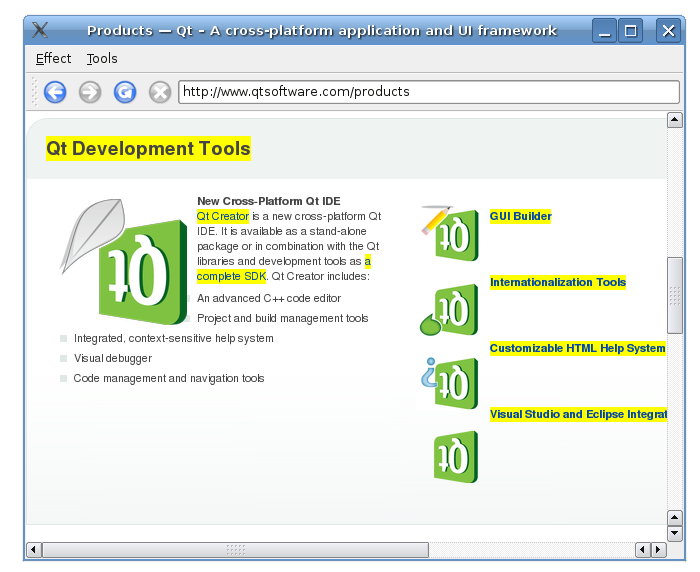
The application makes use of QWebFrame::evaluateJavaScript to evaluate the jQuery JavaScript code. A QMainWindow 采用 QWebView as central widget builds up the browser itself.
The
MainWindow
类继承
QMainWindow
. It implements a number of slots to perform actions on both the application and on the web content.
class MainWindow : public QMainWindow { Q_OBJECT public: MainWindow(const QUrl& url); protected slots: void adjustLocation(); void changeLocation(); void adjustTitle(); void setProgress(int p); void finishLoading(bool); void viewSource(); void slotSourceDownloaded(); void highlightAllLinks(); void rotateImages(bool invert); void removeGifImages(); void removeInlineFrames(); void removeObjectElements(); void removeEmbeddedElements(); private: QString jQuery; QWebView *view; QLineEdit *locationEdit; QAction *rotateAction; int progress;
还声明 QString that contains the jQuery, a QWebView 显示 Web 内容,和 QLineEdit 充当地址栏。
We start by implementing the constructor.
MainWindow::MainWindow(const QUrl& url) { progress = 0; QFile file; file.setFileName(":/jquery.min.js"); file.open(QIODevice::ReadOnly); jQuery = file.readAll(); file.close();
The first part of the constructor sets the value of
progress
to 0. This value will be used later in the code to visualize the loading of a webpage.
Next, the jQuery library is loaded using a QFile and reading the file content. The jQuery library is a JavaScript library that provides different functions for manipulating HTML.
view = new QWebView(this);
view->load(url);
connect(view, SIGNAL(loadFinished(bool)), SLOT(adjustLocation()));
connect(view, SIGNAL(titleChanged(QString)), SLOT(adjustTitle()));
connect(view, SIGNAL(loadProgress(int)), SLOT(setProgress(int)));
connect(view, SIGNAL(loadFinished(bool)), SLOT(finishLoading(bool)));
locationEdit = new QLineEdit(this);
locationEdit->setSizePolicy(QSizePolicy::Expanding, locationEdit->sizePolicy().verticalPolicy());
connect(locationEdit, SIGNAL(returnPressed()), SLOT(changeLocation()));
QToolBar *toolBar = addToolBar(tr("Navigation"));
toolBar->addAction(view->pageAction(QWebPage::Back));
toolBar->addAction(view->pageAction(QWebPage::Forward));
toolBar->addAction(view->pageAction(QWebPage::Reload));
toolBar->addAction(view->pageAction(QWebPage::Stop));
toolBar->addWidget(locationEdit);
构造函数的第二部分是创建 QWebView and connects slots to the views signals. Furthermore, we create a QLineEdit as the browsers address bar. We then set the horizontal QSizePolicy 以随时填充浏览器可用区域。添加 QLineEdit 到 QToolbar 及一组导航动作来自 QWebView::pageAction .
QMenu *effectMenu = menuBar()->addMenu(tr("&Effect"));
effectMenu->addAction("Highlight all links", this, SLOT(highlightAllLinks()));
rotateAction = new QAction(this);
rotateAction->setIcon(style()->standardIcon(QStyle::SP_FileDialogDetailedView));
rotateAction->setCheckable(true);
rotateAction->setText(tr("Turn images upside down"));
connect(rotateAction, SIGNAL(toggled(bool)), this, SLOT(rotateImages(bool)));
effectMenu->addAction(rotateAction);
QMenu *toolsMenu = menuBar()->addMenu(tr("&Tools"));
toolsMenu->addAction(tr("Remove GIF images"), this, SLOT(removeGifImages()));
toolsMenu->addAction(tr("Remove all inline frames"), this, SLOT(removeInlineFrames()));
toolsMenu->addAction(tr("Remove all object elements"), this, SLOT(removeObjectElements()));
toolsMenu->addAction(tr("Remove all embedded elements"), this, SLOT(removeEmbeddedElements()));
setCentralWidget(view);
setUnifiedTitleAndToolBarOnMac(true);
}
The third and last part of the constructor implements two QMenus and assigns a set of actions to them. The last line sets the QWebView 作为中心 Widget 在 QMainWindow .
void MainWindow::adjustLocation() { locationEdit->setText(view->url().toString()); } void MainWindow::changeLocation() { QUrl url = QUrl(locationEdit->text()); view->load(url); view->setFocus(); }
当加载页面时,
adjustLocation()
updates the address bar;
adjustLocation()
被触发通过
loadFinished()
信号在
QWebView
。在
changeLocation()
we create a
QUrl
对象,然后使用它把页面加载到
QWebView
。当新网页加载完成时,
adjustLocation()
will be run once more to update the address bar.
void MainWindow::adjustTitle() { if (progress <= 0 || progress >= 100) setWindowTitle(view->title()); else setWindowTitle(QString("%1 (%2%)").arg(view->title()).arg(progress)); } void MainWindow::setProgress(int p) { progress = p; adjustTitle(); }
adjustTitle()
sets the window title and displays the loading progress. This slot is triggered by the
titleChanged()
信号在
QWebView
.
void MainWindow::finishLoading(bool) { progress = 100; adjustTitle(); view->page()->mainFrame()->evaluateJavaScript(jQuery); rotateImages(rotateAction->isChecked()); }
When a web page has loaded,
finishLoading()
被触发通过
loadFinished()
信号在
QWebView
.
finishLoading()
then updates the progress in the title bar and calls
evaluateJavaScript()
to evaluate the jQuery library. This evaluates the JavaScript against the current web page. What that means is that the JavaScript can be viewed as part of the content loaded into the
QWebView
,因此每当加载新页面时,都需要加载。一旦加载 jQuery 库,就可以开始在浏览器中执行不同 jQuery 函数。
The rotateImages() function is then called explicitely to make sure that the images of the newly loaded page respect the state of the toggle action.
void MainWindow::highlightAllLinks() { QString code = "$('a').each( function () { $(this).css('background-color', 'yellow') } )"; view->page()->mainFrame()->evaluateJavaScript(code); }
首个基于 jQuery 的函数
highlightAllLinks()
,旨在用来突出显示当前网页中的所有链接。JavaScript 代码查找 Web 元素名为
a
, which is the tag for a hyperlink. For each such element, the background color is set to be yellow by using CSS.
void MainWindow::rotateImages(bool invert) { QString code; if (invert) code = "$('img').each( function () { $(this).css('-webkit-transition', '-webkit-transform 2s'); $(this).css('-webkit-transform', 'rotate(180deg)') } )"; else code = "$('img').each( function () { $(this).css('-webkit-transition', '-webkit-transform 2s'); $(this).css('-webkit-transform', 'rotate(0deg)') } )"; view->page()->mainFrame()->evaluateJavaScript(code); }
The
rotateImages()
function rotates the images on the current web page. Webkit supports CSS transforms and this JavaScript code looks up all
img
elements and rotates the images 180 degrees and then back again.
void MainWindow::removeGifImages() { QString code = "$('[src*=gif]').remove()"; view->page()->mainFrame()->evaluateJavaScript(code); } void MainWindow::removeInlineFrames() { QString code = "$('iframe').remove()"; view->page()->mainFrame()->evaluateJavaScript(code); } void MainWindow::removeObjectElements() { QString code = "$('object').remove()"; view->page()->mainFrame()->evaluateJavaScript(code); } void MainWindow::removeEmbeddedElements() { QString code = "$('embed').remove()"; view->page()->mainFrame()->evaluateJavaScript(code); }
The remaining four methods remove different elements from the current web page.
removeGifImages()
移除页面中的所有 GIF 图像通过查找
src
属性 (为网页中的所有元素)。任何元素采用
gif
file as its source is removed.
removeInlineFrames()
removes all
iframe
or inline elements.
removeObjectElements()
removes all
object
elements, and
removeEmbeddedElements()
removes any elements such as plugins embedded on the page using the
embed
标签。
文件: